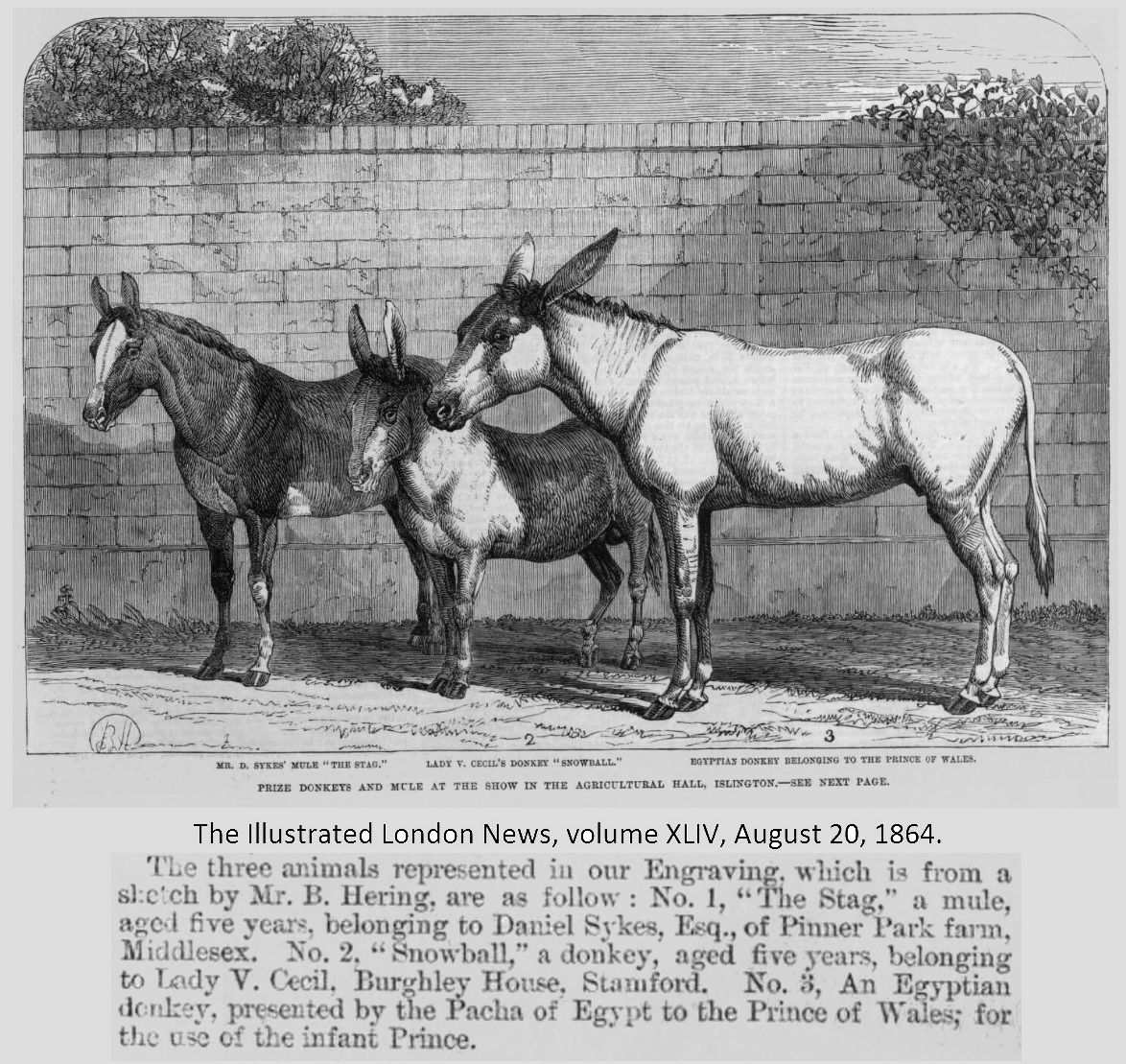
|
HYBRID EQUINES - MULES, MOLLIES AND HINNIES |
|
Father |
Mother |
Offspring |
|
Donkey (jack) |
Horse (mare) |
Mule (male), John (male), Molly (female) |
|
Horse |
Donkey (jenny, jennet (US)) |
Hinny, Jennet (Ireland) |
MULES, MOLLIES AND HINNIES

Mules (donkey stallion/horse mare) are bred as draught animals. Mules and hinnies are depicted in Egyptian art circa 1400 BC and were valued as draught animals by the Romans. Male mules are sterile, but fertile female mules (mollies) sometimes occur and can be mated to either a horse or donkey stallion. In France, the Poitou donkey is used almost exclusively for siring large, strong mules on Poitou horse mares. Jack donkeys are reportedly often reluctant to mate with horse mares and may have to be trained to do so. Miniature mules are produced using smaller breeds of donkey and pony. An article in The New York Times, Thursday Feb 22nd, 1968 entitled "Rare Type Of Mule Kicks Up Heels At Children's Zoo" detailed the birth of a foal to a Shetland pony fathered by a burro at New York's Central Park Zoo. Although sterile, mule stallions are generally castrated to make them tractable.
The hinny (horse stallion/donkey mare hybrid) is less common. The head of a hinny is more horse-like than the head of a mule. They are harder to produce than mules as stallion/jenny matings are less likely to result in pregnancy. Hinnies are smaller and finer boned than mules. This was believed to be due to the donkey mare having a less roomy womb, but the difficulty in impregnation suggests it is largely genetic. Donkeys have 62 chromosomes while horses have 64 chromosomes; hybrids are less likely where the male has more chromosomes than the female.
INFLUENCE OF PARENTS ON PROGENY. The Highland Weekly News, Hillsborough, Ohio, 6th January 1859, page 1.
The following extract from an article in the Journal of the British Royal Agricultural Society, affords a subject for thought and observation, and is interesting and instructive withal:
Much difference of opinion prevails as to the relative influence of the male and female parent in determining the characters of progeny. According to a very prevalent notion, the male bestows all valuable qualities, whether of form or vigor; while the female is regarded merely as a passive instrument which hatches, as it were, the male seed an absurd doctrine long preserved from well merited obloquy as a convenient excuse for carelessness and neglect in the selection of the female parent. A most ingenious hypothesis has lately been propounded by Mr. Orton in the Monthly Medical Journal. The male animal, according to Mr. Orton, influences especially the external, and the female the internal organisation of the offspring. The outward form, general appearance and organs of locomotion are chiefly determined by the male; the vital organs, size, general vigor, and endurance, by the female. Many most interesting facts, of which we subjoin a few, are adduced in support of this proposition. There are many reasons for believing that Mr. Orton's views afford a clue to an important law of physiology. But this, it must be remembered, cannot be the only law operating in the process of generation, and , as Mr. Orton himself states, it must consequently be liable to many modifications, and must only be accepted with certain restrictions. Thus the parent, which at the time of copulation is more powerful and vigorous, doubtless imparts to the progeny an unduly large share of its own most prominent characters. The mule is the produce of a male ass and the mare; the hinny that of the horse and the ass. Both hybrids are the produce of the same set of animals. They differ widely, however, in the respective characters the mule in all that relates to its external characters, having the distinctive features of the ass the hinny, in the same respects, having all the distinctive features of the horse; while, in all that relates to the internal organs and the vital qualities, the mule, partakes of the characters of the horse, and the hinny of those of the ass. Mr. Orton, speaking of this says:
"The mule, the produce of the male ass and mare, is essentially a modified ass; the ears are those of an ass somewhat shortened, the mane is that of the ass erect, the tail is that of an ass, the skin and color are those of an ass somewhat modified; the legs are slender, and the hoofs high, narrow, and contracted, like those of an ass; in fact, in all these respects it is an ass somewhat modified. The body and barrel of the mule are round and full, in which it differs from the ass, and resembles the mare. The hinny on the other hand, the produce of a stallion and she-ass, is essentially a modified horse, the ears are those of a horse somewhat lengthened; the mane flowing; the tail is bushy, like that of the horse, and the color varies also like the horse; the legs are stronger, and the hoofs broad and expanded, like those of the horse. In fact, in all these respects it is a horse somewhat modified. The body and barrel, however, of the hinny, are flat and narrow, in which it differs from the horse, and resembles its mother, the ass.
"The mule and hinny," adds Mr. Orton, "have been selected and placed first, because they afford the most conclusive evidence, and are the most familiar." Equally conclusive, although perhaps less striking instances, may be drawn from other sources. Thus it has been observed, that whenever the Ancona, or other sheep, are allowed to breed with common ewes, the cross is not a medium between the two brees, but that the offspring retains in a great measure the short and twisted legs of the sire. Buffon made a cross between the male goat and the ewe; the resulting hybrid in all instances, which were many, were strongly characteristic of the male parent, more particularly so in the hair and length of the leg. Curiously enough, the number of teats in some of the cases corresponded with those of the goat. A cross between a male wolf and a bitch illustrates the same law; the offspring having markedly wolfish aspect, skin, color, ears and tail. On the other hand, a cross between the dog and female wolf afforded animals much more dog-like in aspect slouched ears and even pied in color. If you look to the descriptions and illustrations of these two hybrids, you will perceive at a glance that the doubt arises to the mind in the case of the first, "What genus of wolf is this?" whereas in the second, "What a curious mongrel dog!"
According to the "Illustrated Natural History" by the Rev JG Wood (1853, 1874): The cross-breed between the horse and the ass, which is commonly known by name of the Mule, is a very valuable animal for certain purposes, possessing the strength and power of the horse, with the hardiness and sure foot of the ass. The largest most useful Mules are those which are produced by a male ass and a mare, the large Spanish Ass being the best for this purpose. In Spain and in many eastern countries the Mule is an animal of some importance, the parents being selected as carefully as those of the horse itself. The chief drawback in the rearing of this animal is that it is unproductive, and is incapable of continuing its species, so that there can be no definite breed of Mules, as of horses and asses.
In "The Variation Of Animals And Plants Under Domestication" Darwin wrote: "The ass has a prepotent power over the horse, so that both the mule and the hinny more resemble the ass than the horse; but that the prepotency runs more strongly in the male-ass than in the female, so that the mule, which is the offspring of the male-ass and mare, is more like an ass, than is the hinny, which is the offspring of the female-ass and stallion." In "The Variation Of Animals And Plants Under Domestication" Darwin elaborated: "Colin, who has given in his 'Traite Phys. Comp.' tome 2 pages 537-539, [...] is strongly of opinion that the ass preponderates in both crosses, but in an unequal degree. This is likewise the conclusion of Flourens, and of Bechstein in his 'Naturgeschichte Deutschlands' b. 1 s. 294. The tail of the hinny is much more like that of the horse than is the tail of the mule, and this is generally accounted for by the males of both species transmitting with greater power this part of their structure; but a compound hybrid which I saw in the Zoological Gardens, from a mare by a hybrid ass-zebra, closely resembled its mother in its tail."
THE KIANG (The Field, 29th April 1893) Major Hay states that in Tibet the kiang breeds with the horse, and that their produce is highly valued; and he adds, but not on his own knowledge, that the hybrids are regarded as fertile, which is in the highest degree improbable. Professor Cossart Ewart crossed kiangs (a type of wild ass) to ponies to test the theory that the then newly discovered Przewalski horse was a hybrid rather than a distinct species. This summary appeared in the Western Times (among others) on 30th June, 1903 "THE WILD HORSE. INTERESTING DISCUSSION OF NEW BREED" which is reproduced in full on another page (see main index).
COLT AND MULE BIRTHS STARTLE KENTUCKY FARMER. Daily Press (Newport, Virginia), 26th April 1939, page 12.
Lawrenceburg, Kentucky. Farmer Ben Critton was duly surprised when his five-year-old Percheron work mare gave birth to twin foals. But he nearly collapsed from excitement when he discovered one of the phenomenal foals was a colt [i.e. horse foal], the other a mule. The dam first was bred to a jack, Critton said, and 20 days later to a stallion.
COLT AND MULE BIRTH IN FIVE POINTS AREA CITED. The Circleville Herald, Ohio, 22nd May 1939.
The recent newspaper account from London, O., concerning a five-year-old mare foaling a colt and a mule at the same time recalls to Pickaway county residents a similar incident on a farm near Five Points about 15 years ago. Harry J. Briggs, service manager of the Farm Bureau, recalled that a mare owned by John Huston of Five Points, foaled a colt and a mule. The chances of twins being born to a mare are 25,000 to one. There are no statistics on the chances of te twins being of mixed breeds.
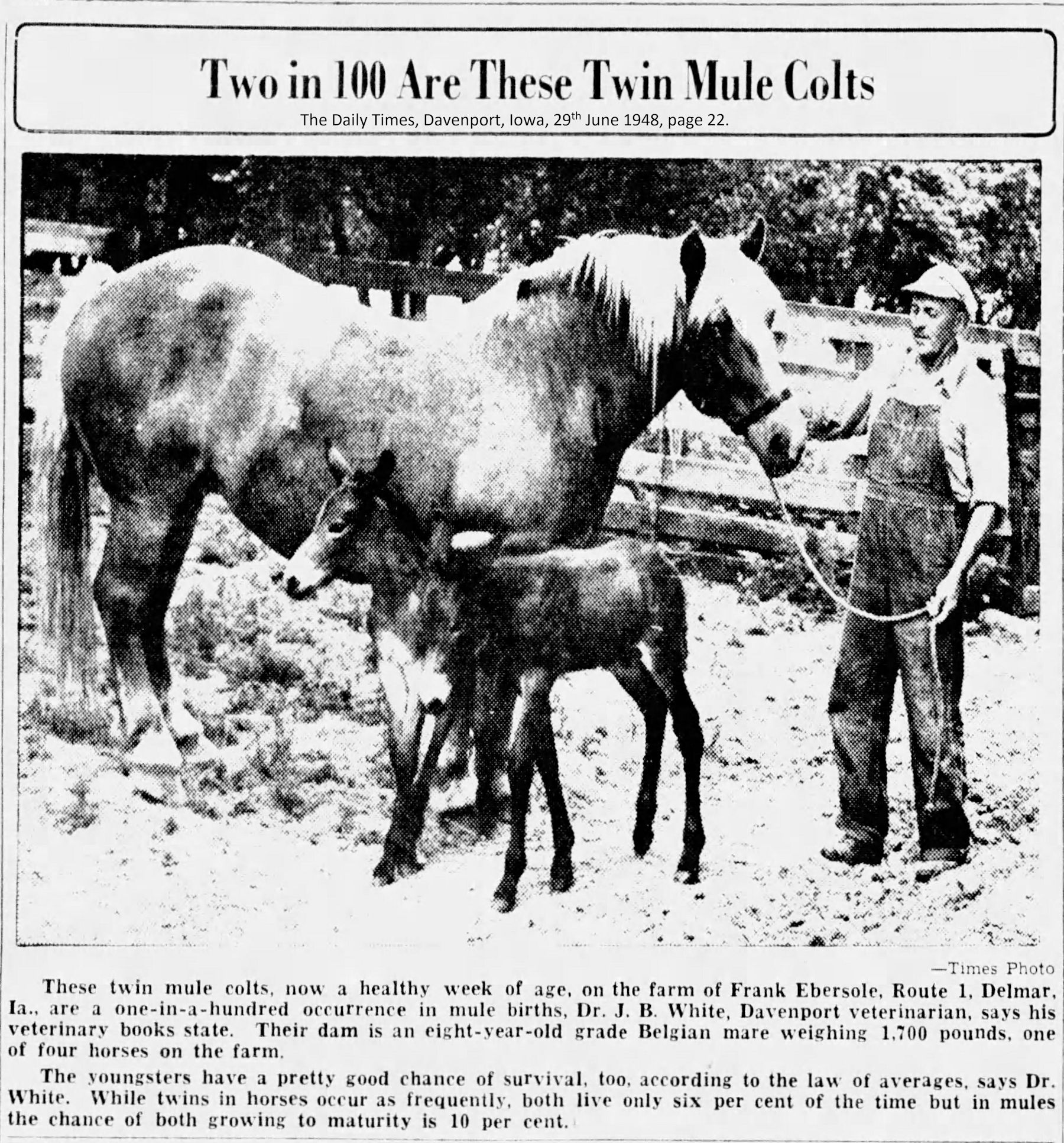
TWO IN 100 ARE THESE TWIN MULE COLTS. The Daily Times, Davenport, Iowa, 29th June 1948, page 22.
These twin mule colts, now a healthy week of age, on the farm of Frank Ebersole, Route 1, Delmar, Ia., are a one-in-a-hundred occurrence in mule births, Dr. J.B. White, Davenport veterinarian say his veterinary books state. Their dam is an eight-year-old grade Belgian mare weighing 1,700 pounds, one of four horses on the farm. The youngsters have a pretty good chance of survival, too, according to the law of averages, says Dr. White. While twins in horses occur as frequently, both live only six percent of.t the time but in mules the chance of both growing to maturity is 10 per cent.
HINNIES
While mules have been bred throughout history for their strength and resilience, the reciprocal cross the hinny, jennet, or "mare-mule" is much less common. Here is a selection of news reports about hinnies and their rarity.
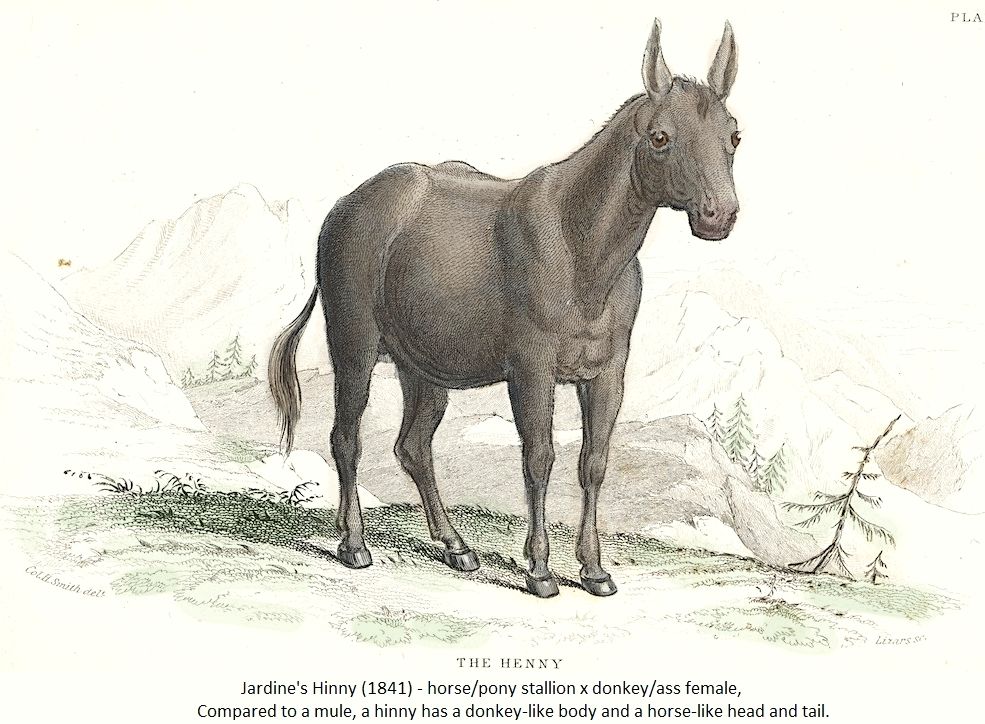
THE BREEDING OF HINNIES. The Pickens Republican, Carrollton, Alabama, 7th June 1860, page 1
The Eastern Clarion, Paulding, Mississippi, 2nd May 1860, page 1. Probably no branch of stock-growing would pay better at the South than the breeding and rearing of hinnies, provided that the business was properly embarked in, and conducted with sound judgment. It is a serious and insupportable objection to the extensive breeding of mules that mares are thereby prevented giving birth to their own noble species, which would inevitably become extinct in a few years if all females were bred to males of the inferior ass. On the contrary, if the South was properly stocked with the best she-asses, that may be had much cheaper than Jacks in Southern Europe, North Africa, and in Syria, because there is no foreign demand for them, these females, bred to suitable stallions, would soon supply planters and the public generally with hinnies of considerable economical value; and in this way all mares would be left to increase the number of horses in the country. The fact is not to be disguised that really desirable carriage and saddle horses are becoming a rather expensive luxury; while the high price of good mules is calculated to aggravate the evil by constantly diminishing the number of male colts [foals] born and reared for breeders of either mules or horses. So far as any increase of horse flesh is concerned, our present practice is equivalent to spaying one half or more of all the female foals that come into the world.
There is a well defined and material difference between a mule and a hinny, we will briefly describe. The hinny neighs like his father, the horse, and pretty closely resembles him throughout in anatomical structure and organic development. He has the fine head, ear and neck, the flowing mane and full tail, the broader feet, and larger and wider set legs of the horse. In the mule, the form of the ass is more strikingly developed. The mule always brays like its father, and cannot neigh like its mother. Its long, thick, and ugly head and ears, its trifling mane and feet, its hardiness, surefootedness, temper and disposition, not less than its voice, prove beyond a reasonable doubt that the blood of the ass much improved by infusion of superior blood; and at the same time a hybrid so contrary to the pure conservatism of nature, that it cannot propagate its mongrel and corrupt specific analogies. The hinny is equally infertile, but as I is as much a horse as the mule is an ass, it is superior to the mule as a riding animal, and for all light draught and carriage purposes. It cannot subsist on coarser fare than the horse, although not quite so long lived as the mule, or its own mother. The Romans appreciated the Hinnies highly, as a substitute for the horse, and derived its name from hinnire, to neigh, to distinguish it from the Hemionus (half-ass) or mule.
We can hardly imagine a more promising enterprise than one or more farmers to import a cargo of the best Maltese female asses and breed them to Morgan stallions, whose size and blood would give offspring compact in form, beautiful in figure, and alike distinguished for action, speed, and powers of endurance. Southern sagacity and capital have already given no inconsiderable amount of the best male blood of the horse kind for breeding purposes; but our stock of brood mares is, as a whole, small in quantity and defective in quality. We should be glad to see it improved in both respects, and regard the propagation of hinnies as likely to promote that consumation. It is probably that we shall have more to say on this subject; and we invite suggestions from our readers.
In this connection, we copy a paragraph from Herbert's late and valuable work entitled "Hints to Horse-keepers": "It is generally asserted that the hinny has been tried and found neatly a worthless animal, though admitted to be a beautiful one. He has been tried only occasionally in Spain, since the great decline in the number and quality of the male asses, arising from the frightful consumption of those animals during the Peninsular war and the subsequent incessant civil wars which have convulsed that unhappy country, has rendered it necessary to supply their want. We are not inclined to adopt this assertion. We believe that the hinney, so far from being a worthless animal, is as good as he is handsome, and superior to the mule for the use for which he is fitted that is for a saddle animal. But being inferior to the horse as a saddle animal, and inferior to the mule as a beast of draght or burden, in which respect alone the latter can compete with the horse, he has no special place of his own; and, therefore, it having been worth no one's while to cultivate hinnies, they have fallen into disuse and got a bad name. It may, however, well be doubted whether in the great demand and inadequate supply of handsome, clever ponies, suited for to carry boys, young ladies, and timid, or valetudinarian, or aged persons, who require horse exercise, it might prove an exceedingly paying speculation to import a few of the finest and largest sized Maltese or Arabian female asses (which, by the way, command no price, as compared with the Jack), and to breed from them to the best and highest bred, undersized, thoroughbred stallions. We have seen abroad, in past years, one or two hinnies with ears but a little larger than those of a coarse poney, with long, thin males, full tails, sleek, shining coats, which were altogether beautiful animals. They have a good deal of spirit, and the patience without the stubbornness of the ass."
WHAT IS A MULE? The Pittsburgh Daily Commercial, Pennsylvania, 30th June 1865, page 3.
After so much said about mules, it will be deemed folly, by some, to ask the question, "What is a mule?" The answer will, nine times out of ten, be, "a hybrid, between the horse and the ass." Yet it is not exactly correct, for the hybrid between the horse and he ass will produce two distinct races of animals, as different from one another as a horse is different from a mule. One of these, the offspring of the male horse or stallion and the female ass, is the hinny (from the Latin hinnus, the derivative of the word hinnire, to neigh). This animal is characteristic of the horse, which he closely resembles in many qualities; but he also inherits the hardy constitution and activity of his mother, the ass. One distinguishing feature of the hinny is that he neighs like the horse, and his ears are smaller and his feet larger that the mule proper. In every respect he partakes more of the character of the horse than the ass. The second hybrid between the male ass or the jack and the female horse or mare, is the mule (from the Latin hemionus or half-ass). This hybrid takes after his sire, as in the case of the former hybrid. I have never had any experience with the hinny, but have heard it said they were preferable to the mule for pleasure, travelling, but not for draught. Cor. Ger, Telegraph.
The Democratic Advocate, Westminster, Maryland, 1st June 1871, page 1.The Hinny is the offspring of the Stallion and the Jennett, or she Ass, and is a very different and inferior animals to the Mule, which is the offspring of the Mare and Jack. Both are incapable of propagation, being hybrids. The Mule is fond of the horse, and will follow wherever the horse leads, hence there is no trouble in conducting droves of them, if a man rides before them on a horse. The Hinny does not manifest this peculiarity. It is a less sprightly and less serviceable animal, and does not seem to be as proud of its kinsman, the horse, as the Mule is.
BREEDING. North British Agriculturist, 24th December 1879, page 833.
Why, again, in the mule, is the produce of the male horse and the she ass utterly distinct from that of a stallion donkey and the mare? So different, indeed, is one from the other, that there is a distinctive name for it in England, Viz., the 'Hinny,' the mule being almost invariable the offspring of the male ass and the mare, the 'Hinny' being very seldom bred.
HORSE BREEDING AND MANAGEMENT By Frederic Adye {Excerpt]. {Nottinghamshire Guardian, 24th June 1899, page 7.
It is generally supposed that in the cross the donkey influence predominates over that of the horse, and this certainly seems to be the case, both in appearance and characteristics, in regard to the mule; but it is not so apparent in the hinny, or jennet, as it is sometimes called. One which I knew was quite as much like a pony as a donkey. Very few of these are met with in England, but in Ireland they are more common, especially in Tipperary and Mayo, where a good Welsh pony was stationed a few years ago for the express purpose of breeding this animal. For trotting work in light cartsthe jennet is more suitable than the heavier-bodied mule, and being the offspring of two such enduring animals as the pony and donkey he naturally inherits this quality, as well as that of longevity. He is also extensively used I believe in the Neapolitan district, and in the Island of Sardinia.
MULES FOR THE FARM. The Duke Times, Duke, Oklahoma, 6th September 1912, page 3.
In Kentucky many breeders are mating jennets [she-asses] to the very best trotting stallions, producing hinnies. No one could guess their breeding. Recently I saw one in Louisville that was a wonderful animal. The owner had refused $1,000 for him. His side was like seal skin, ears like rabbits, and he could trot in 2:30. A great many hinnies are being raised in the mountain districts, and they sell at prices ranging from $250 to $400.
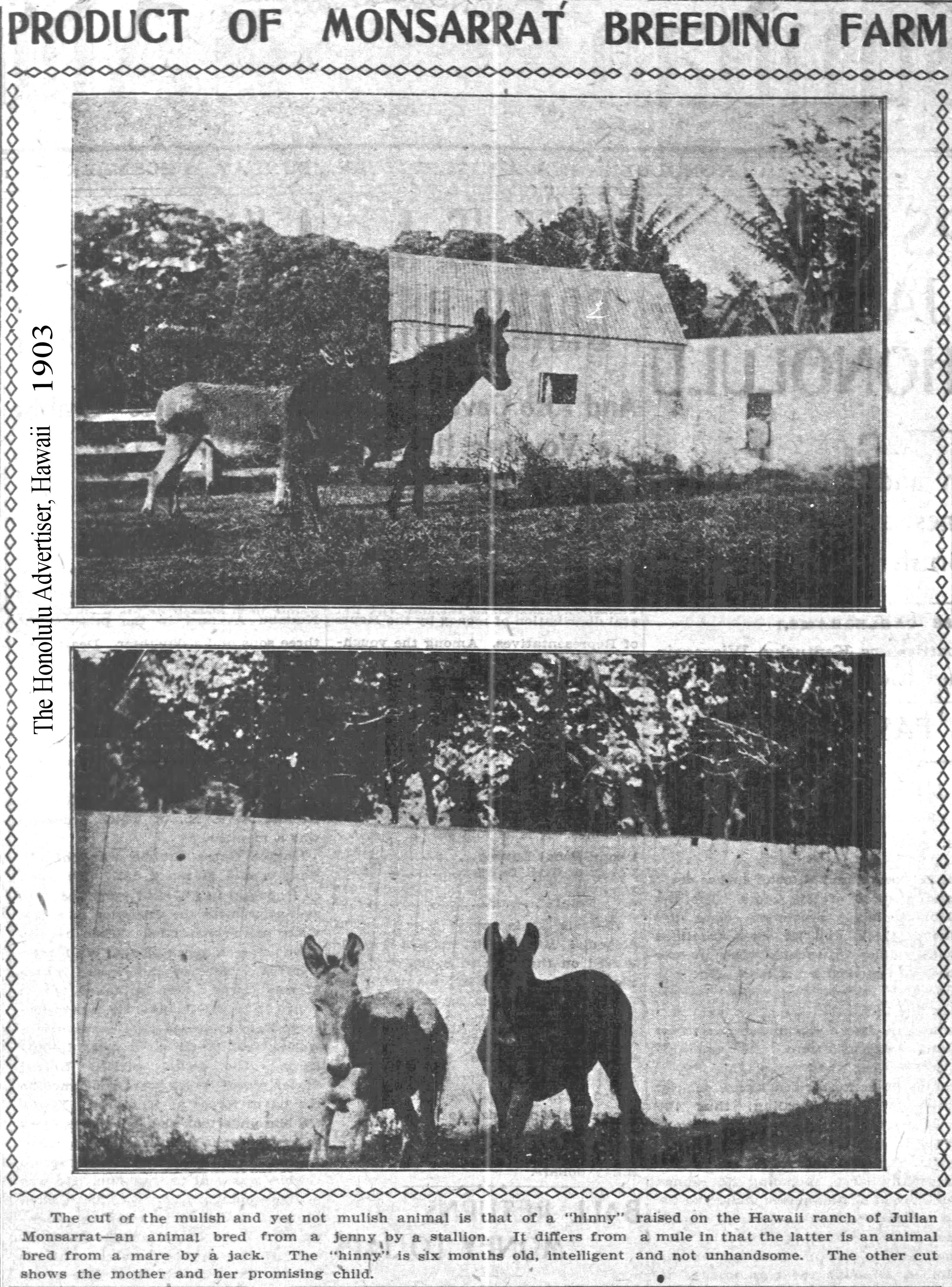
HINNIES, A STRANGE HYBRID, TO BE USED FOR DELIVERY PURPOSES HERE. The Honolulu Advertiser, Hawaii, 28th August 1913, page 9.
Three hinnies appeared on the streets of Honolulu yesterday, being the first time this hybrid has come into public view in the Hawaiian Islands. Unlike a mule, and unlike any other cross-breed, the hinny, sired by a stallion and dammed by a jenny, stands alone in its classification. Henry May & Co., the grocers, bought the animals from Julian Monsarrat, manager of Kapapala Ranch, Hawaii. The firm will be the first in Honolulu to use hinnies for their delivery wagons. An account of the birth of these little animals was published in The Advertiser a few years ago and the story created a great deal of interest among horse and cattle breeders at the time.
As an indication of their extremely docile nature, Manager Swift of the grocery company states that one of the little animals was placed in harness early yesterday morning for the first time, and was then driven over the city without any difficulty. Later, all three were put in harness. They did not attempt to shake off the straps and appeared to understand what was wanted of them with the tug of the reins. The appeared to be a trifle nervous on meeting cars, autos and motorcycles, but did not become frightened.
Manager Monsarrat, in a letter to E.A.R. Ros, of C. Brewer & Co., relative to the hinnies gives their genealogy as follows: "These are the only hinnies ever bred on the Islands. They were sired by a son of 'The Mallard,' and you know what he was, one of the best thoroughbred stallions ever imported to these Islands. Today we are using the sire on cattle and he is one of the best we have, chock full of grit and endurance. Blood will tell, an these hinnies have the thoroughbred in them. The brown stands 13.1-and-a-half hands, and the buckskin 13.1 hands, the latter being splendidly matched in every way. I should judge each weighs about 750 pounds. They are so gentle under saddle, that there should be no trouble to break them to harness, provided they are handled by a man who will not abuse them in the breaking, for they are timid, but of a fine disposition. After having run out a whole year, they were taken up, a saddle thrown on them, and not one of them showed a buck, or any signs of temper. Can you beat this with your scrub Hawaiian mule? You were here and can corroborate what I say as to their gentleness. They have got their brother hybrid, the mule, backed off the earth, in this respect.
"I quote you from Captain Hayes, a noted English authority: 'Hinnies resemble the ass more than the horse in their placid temper, greater adaptability to work and longevity. In carrying and drawing loads they are superior to the horse of the same weight and they can obtain the necessary energy from food the horse cannot digest.' Another thing to be considered is that the hinny is the most difficult of all hybrids to breed, as nine out of every ten die at birth."
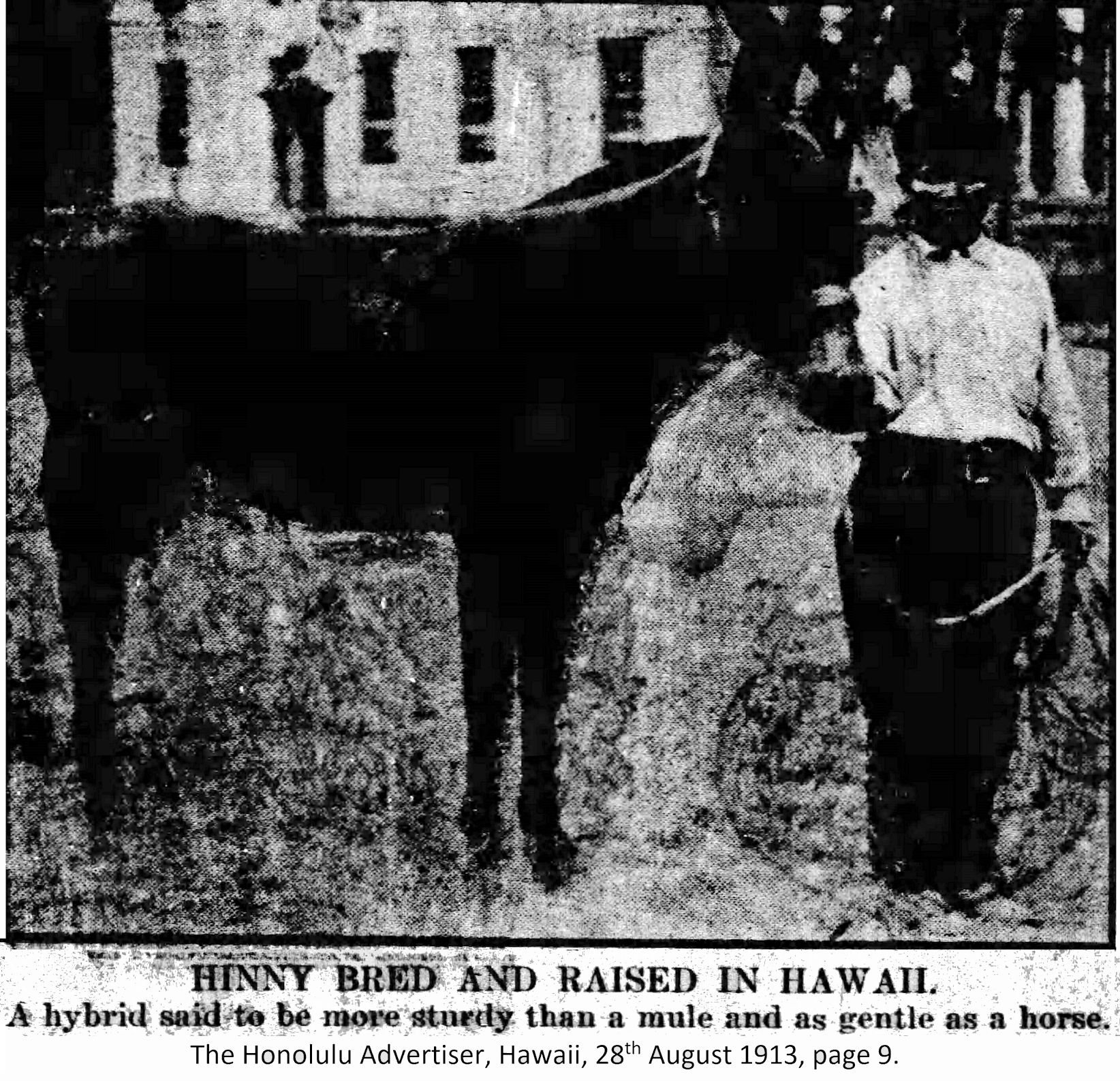
NOTES ON MULE. Mid-Lothian Journal, 25th December 1914, page 7.
[. . . ] The hinny is rarely met with in this country. It is produced by mating a stallion with a female donkey; and it runs smaller in site well as appears less slightly and finished. There is well founded prejudice against the hinny to the effect that it is less adapted for heavy work than is the mule. William Toogood. Southampton.
GIVES BIRTH TO HINNY. The Frankfort Index, Kansas, 26th May 1937, page 3.
A. J. Wempe, Percheron horse breeder living west of town, has a jennet that recently gave birth to a hinny. Mr. Wempe crossed the jennet with a purebred sorrel Percheron stallion to get the unusual colt. The various breeds of the ass belong to one species Known as Equus asinus and the breeds of the horse belong to a distinct species known as Equus cabalus. The male ass is called a "jack" and the female a "jennet." The cross of a jack and a mare produces a hybrid known as a "mule." The cross of a Stallion and a jennet produces a hybrid known as a "hinny." It has often been said that the hinny and the mule differ in appearance, the hinny tending to be more like the horse and the mule tending more toward the type of a jack. Very few hinnies are produced, as jennets are in such demand for producing jacks that they are seldom bred to stallions. Mules and hinnies do not breed, being infertile. The young hinny which has attracted so much attention among horse breeders proves the old saying, "the mule has no pride of ancestry, and no hope of posterity."
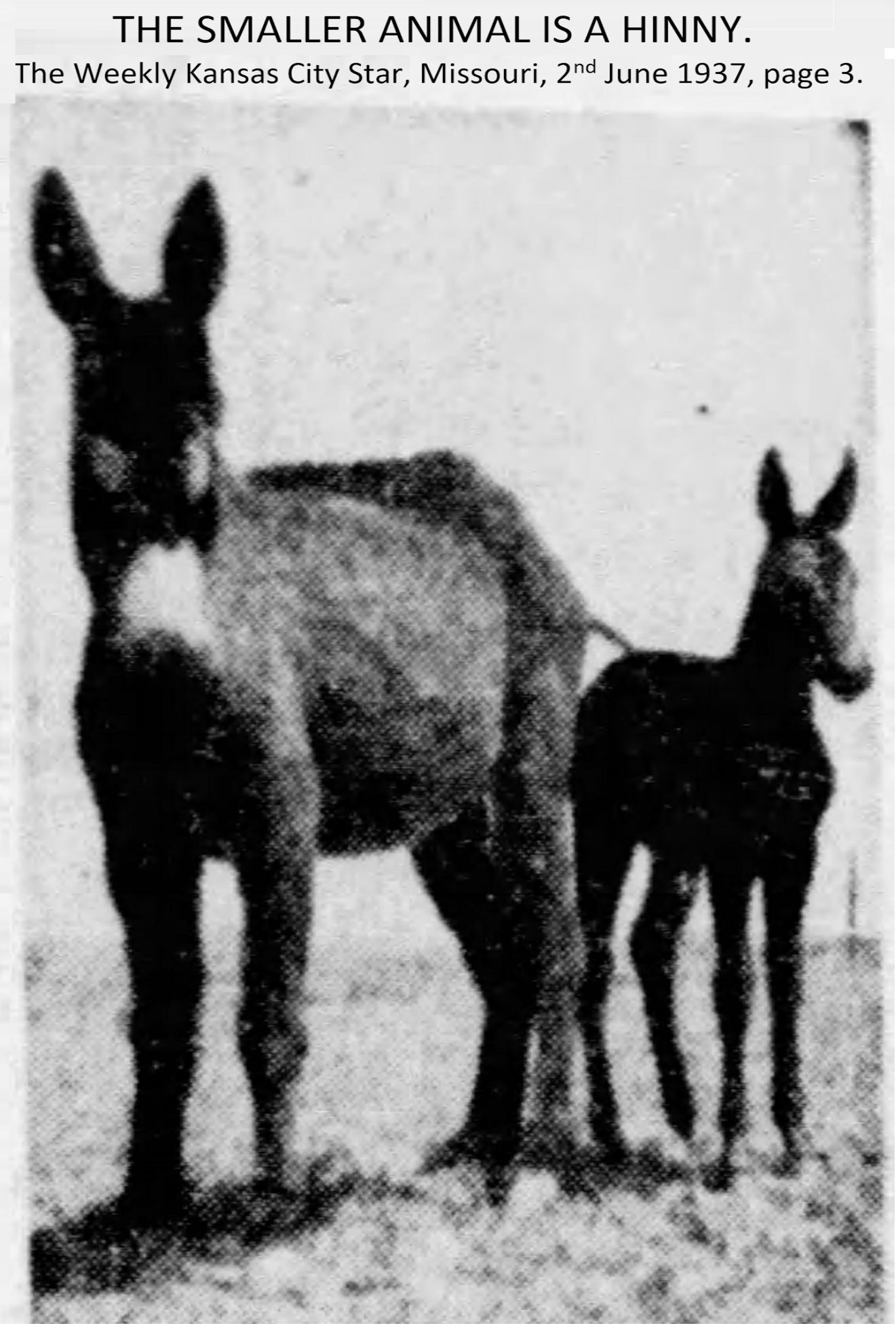
THE SMALLER ANIMAL IS A HINNY. The Weekly Kansas City Star, Missouri, 2nd June 1937, page 3.
A.J. Wempe, Marshall County horsemen living near Frankfort, Kas., has a jennet which recently gave birth to a hinny. He crossed his jennet with a purebred sorrel Percheron stallion and the offspring is a fine dark black colt resembling a mule. Horse breeders have come many miles to see the unusual colt, now three weeks old. [Note: Percherons are draught horses that are either grey or black, not sorrel (chestnut)]
NEITHER MULE NOT HORSE, 'HINNY' IS EXHIBITED AT FAIR. The Decatur Herald, Illinois, 11th August 1947, page 17.
Springfield, Aug. 11. The mule barn at the Illinois State fair today housed a hardy looking white young colt with the bray and ears of a young mule but looking very much like a horse. The animals is a hinny the offspring of a female donkey (a jennet) and a stallion. Irwin Curtis of Arrowsmith, Ill., head of the fair's mule department, said the hinny was the first to be exhibited in the 91-year history of the exposition. It is owned by David Dodds, Virginia, Ill., mule and palomino horse breeder. Attempts to cross a jennet with a stallion usually are ineffectual of result in a stillborn offspring, Curtis said. Dodds said the hinny was the second he had encountered, and the first white one he had seen. It was sired by an albino stallion, Dodds said.
The Delta Democrat Times, Greenville, Mississippi, 19th June 1952, page 11.A little research cleared up our hazy picture of the ule's genealogy. A hybrid, the true mule is the offspring of a mare and a jack the male ass. The animal resulting from this cross is more desirable as a work animal than the hinny, or mare mule, which is the product of a cross between a stallion and a jenny the female ass. There are several hazily authenticated cases in which a hinny has given birth to a colt either horse or ass, depending on paternity; but the mule and the hinny generally are sterile, and in all cases unable to reproduce their own kind.
SHE ASS FOALS COLT, GETS 'THE COMICALEST THING' - IT'S A HINNY. Oroville Mercury Register, California, 6th July 1950, page 12.
Pontiac, Mich. A she ass foaled a colt by a palomino stallion and owner Art Thorne said 'It's the comicalest thing I ever did see.'' Jackasses usually are mated with mares to produce mules, but Thorne reversed the process successfully and got a hinny. "I arranged the match to get something strange," Thorne said, "and I sure did." The colt [foal], which frisked around Thorne's riding stable at nearby Rochester an hour after birth, is light in color, has a tail like a deer, and ears longer than a horse's. "You'd know to look at it," Thorne said, ''that it wasn't no horse and wasn't no mule."' Thorne, 55, said the animal was in good health "as strong and big as any colt I ever saw."
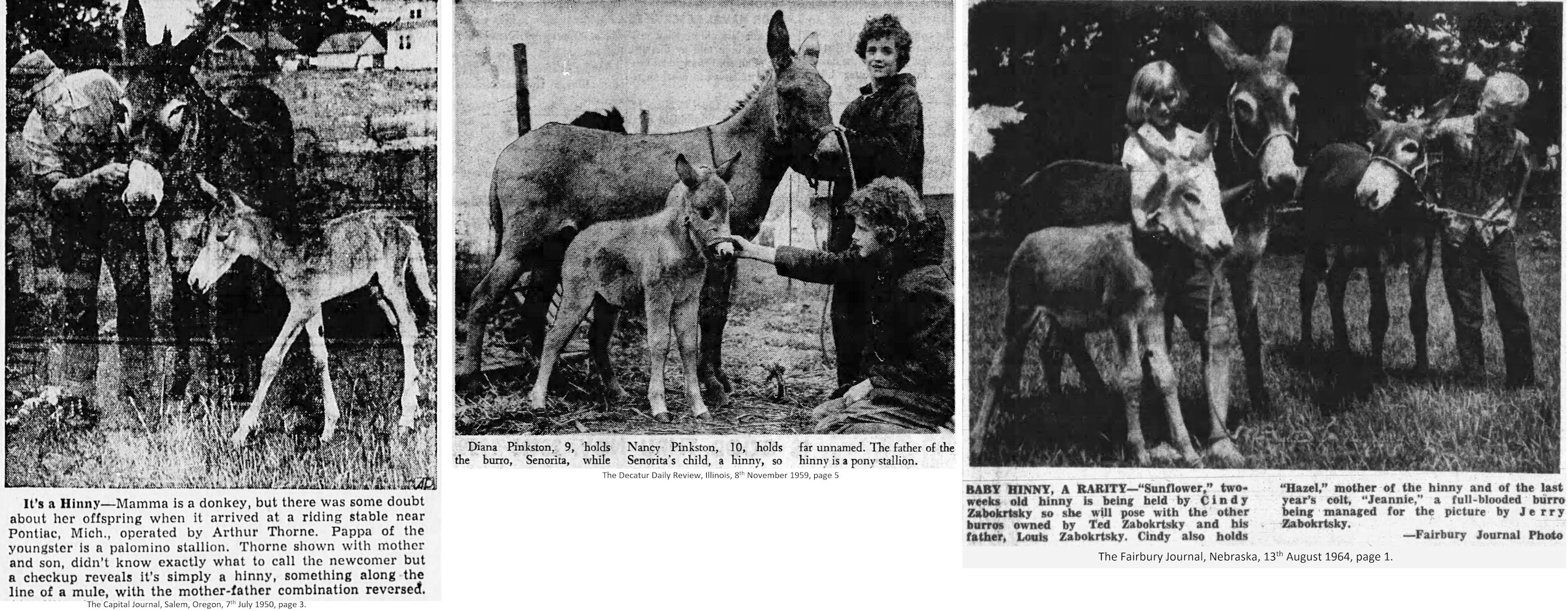
PALOMINO STALLION MATED TO DONKEY RESULT IS HINNY. The Waco News-Tribune, Texas, 7th July 1950, Section II, Page 11.
Rochester, Mich. - Arthur Thorne runs a riding stable in this fashionable suburban district north of Detroit. In his stable, he has a lot of riding horses, a palomino stallion called "Little Joe," and a Jenny donkey. He wondered what would happen if he mated Little Joe and Jenny. [. . . ] The vets told Thorne to hold on the the critter "It might have value to a circus" especially if he looks more like papa as je grows older. Throne thought the vets had something there. So he he's named the little fellow "Something."
IT'S A HINNY. The Capital Journal, Salem, Oregon, 7th July 1950, page 3.
Mamma is a donkey, but there was some doubt about her offspring when it arrived at a riding stable near Pontiac, Mich., operated by Arthur Thorne. Pappa of the youngster is a palomino stallion. Thorne shown with mother and son, did know exactly what to call the newcomer but a checkup reveals it's simply a hinny, something along the line of a mule, with the mother-father combination reversed.
ANIMAL IS CROSS BETWEEN A "HINNY" AND A STALLION. The Daily Herald, Biloxi, Mississippi, 8th July 1950, page 10.
[This report erroneously used "hinny" to refer to a female donkey, which is a "jenny."]
Rochester, Mich. What do you call the baby when its mama is a hinny and its papa a stallion? So far, the best that's been done here is to call it the "something" colt. It was born of a riding stable romance between a palomino stallion and the hinny, according to Arthur Thorne, the stable operator. The hinny and the stallion mated. The result, said Thorne is a little animal "about the size of a real small colt [foal]." It was born on the Fourth of July.
"It doesn't look much like a horse and nothing like a mule. It's just an active little 45-pound something," Throne said. A hinny, which is clearly not a mule, is a hybrid between a stallion and an ass. In this instance the mother hinny is brownish colored. The stallion, Joe, is yellowish and has a white mane. "Something" is also yellowish. "Veterinarians tell me," said Thorne, "it might be the only animal of its kind."
ASININE HINNY JUST HONEY AT DRAWING HORSE LAUGHS. The Welch Watchman, Oklahoma, 28th July 1950, page 5.
A frolicking "hinny," half horse and half jackass, is kicking up a full-fledged furor in Art Thorne's pastures these days. Born to a stallion and an ass Tuesday, the 45-pound "Thing" is drawing horse-laughs from its stable-mates and gapes of disbelief from scientists. It has the color of its Palomino father, ears like its mother, a colt's gangly legs and a tail like a deer. Said Thorne, a breeder of horses for 15 years: "I knew when I tried this something strange would turn out. Ain't it the comicalist thing you ever saw,"
Thorne, 55, owner of a riding stable near Rochester, explained he mated Little Joe, a four-year Old stallion, and Honeybelle, a six-year-old ass, last July. He's pleased with the results, he said, but things haven't been the same around the barns since the whinny-less "hinny" showed up. Said Thorne: ''Honeybelle is more ashamed than proud, I think. When it was being born, all the others came around to watch and heckle - and she upped and kicked a couple of them. And Little Joe, who is ordinarily pretty ornery, is getting orney'er by the day. I think he figures the others are laughing at him."
Thorne said the University of Michigan called him up yesterday "to tell me what had happened couldn't happen." Said he: "They said you can breed a jackass with a mare and get a mule, and a jackass with an ass and get more of the same, but you can't do what I did. I guess Honeybelle and Little Joe didn't know about these rules," Actually, Thorne said, the caller admitted, it wasn't an impossibility - "he said it was just a rare thing that comes close to being a miracle."
Thorne revealed he has already mated his other ass, a 12-year-old Jenny, with another of his 40 horses, and hopes to raise a whole stable-full of '"'hinnies."' Also, he said, maybe he can breed one "thing" with another: "This hybrid has a tail like a deer. Maybe a purebred could run like one and still look enough like a horse to fool the race track stewards."
MICHIGAN'S HINNY DIES; RARITY IN STOCK WORLD. The Hastings Daily Tribune, Nebraska, 21st February 1951, page 14 and many other newspapers.
ROCHESTER, Mich. Farmer Arthur Thorne's hinny was not long for this world. The little fellow died Tuesday at the age of eight months. Thorne said the animal had got tangled up in his stall, suffering fatal injuries. Birth of the hinny caused a lot of talk in barnyard circles. It was the offspring of a palamino stallion and a jenny. It had the sire's yellow coat and the fame [female] ass's long ears. The hinny had been exhibited as a rarity at the Michigan State Fair and livestock shows.
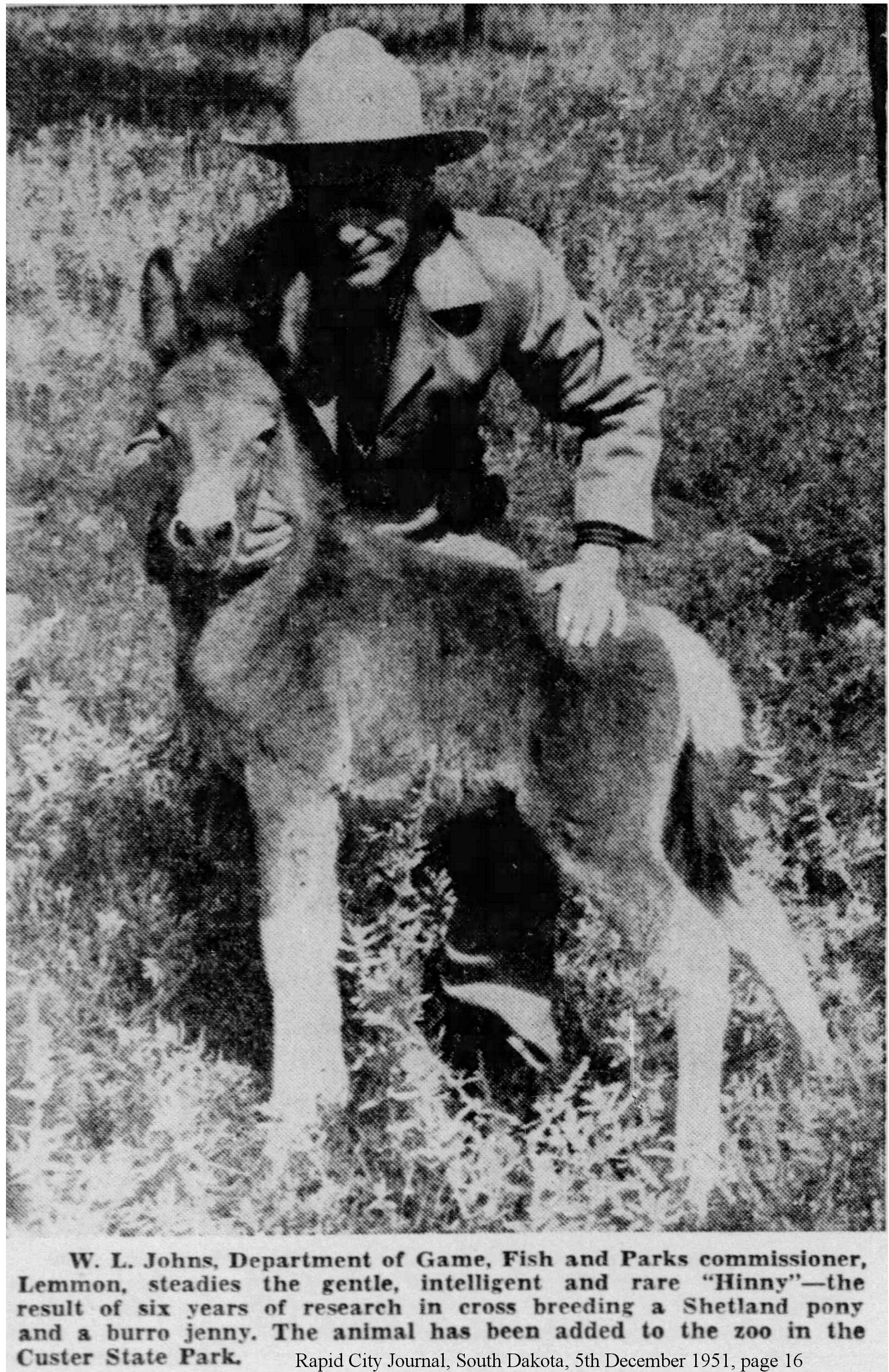
RARE HYBRID ANIMALS, "HINNIES," ROMP AT CUSTER PARK FARM. Rapid City Journal, South Dakota, 5th December 1951, page 16; Argus Leader, Sioux Falls, South Dakota, 9th December 1951, page 32.
Aside from the nationally publicized buffalo herd, Custer State park is the locale for three of the mid-west's most unusual animals. The rare hybrid attractions are "hinnies," the reciprocal cross between a Shetland pony stallion and a burro jenny, which today are grazing on the pasture lands of the Custer State park farm located 15 miles south of Keystone. Two of the animals were born during the summer of 1950, while the third, a black and white spotted hinny, was realized this fall. The new hybrid differs from the other two in that the first hinnies were predominately mule in formation while the latter possesses characteristics of the stallion.
"In securing this spotted hinny we have achieved something which we started out to do six years ago," said W. L. Johns, game, fish and parks commissioner from Lemmon.
The new hinny has white stockings on all four legs, a patch of white on the tail and on the tip of the nose. It is an extremely playful pet and is easily trained which in itself is quite a contrasting feature when comparing it to the stubborn attitude of the Shetland pony and the burro.
"Many tempting offers have been received for the purchase of the hinnies but to date there has been no contemplation of sale. These animals are very rare and because of their scarcity and intelligence they are very much in demand, especially by circuses," Johns said.
Johns, who possesses a keen interest in horses and especially in the hybrid strains, gives much of the credit for the birth of the animal to Louis Meyers, former caretaker at the state farm. During the spring of the year the three hinnies will be on display at the Custer State park zoo as an additional attraction for the countless thousands of tourists who visit the park each year.
RARE ANIMAL IS BORN ON FARM IN GRUNDY COUNTY. The Times, Steator, Illinois, 10th July 1958, page 5.
Morris. James Phillips, a Wauponsee township farmer, is the proud possessor of one of the rarest of farm animals, a hinny, born on the farm. With its mother, pastured in a small orchard at the Phillips farm, the hinny has already attracted considerable attention. A hinny is a hybrid animal, the product of a stallion and a female ass. The Phillips' hinny is a product of a Shetland pony stallion and five year old Mexican mare burro. It is the exact reverse of a mule which is a hybrid cross of a male mule [it should say "ass"] and a mare. It also differs from a mule in that it has a more bushy tail, like a horse, and is of a very gentle disposition. This little fellow also has four white feet and appears to be wearing bobby sox. Phillips explained that the mother burro was a Father's Day gift rom his grandchildren because "they couldn't stand to look at it." The children today are perfectly willing to be Indian givers and take back their gift.
BRAY PLUS WHINNY EQUALS ONE HINNY. Dayton Daily News, Ohio, 24th April 1959, page 9.
TOLEDO. Mom brays. Pop whinnies. What a mixed-up world this is for hinnies . . . Mom is Pokey, a five-year-old Mexican burro whose pad is on the Albert Hartman farm in neighboring Wood county. Pop is Ginger, a Shetland pony of the same age and address but opposite gender. The two became in rapport some months ago and the result, at 3 a.m. last Tuesday, was the birth of a hinny. And that's the way it is, farmer Hartman explains, when female donkey or burro mates with a stallion. Hartman said hinnies are quite rare, especially in this part of the country.
FIRST HINNY IN CARROLL COUNTY IS FOALED IN BURRO The Chillicothe Constitution Tribune, Missouri, 21st June 1960, page 15.
One of the most unusual animal specimens of domestic animals ever brought forth in Carroll County is a hinny which was foaled early Friday morning on the farm of Dickson Brothers east of Carrollton on Highway 24. The strange creature is the property of Alice Ann Brand, daughter of Mr. and Mrs. Dan A. Brand of Carrollton. It should be explained that a hinny is a hybrid animal that is parallel to a mule but the parentage of it is reverse from that o a mule. In this instance the dam of this unusual foal is a Mexican burro while its sire is a stallion owned by Klank Miller. This may be the first hinny that was ever foaled in Carroll county for inquiry among several of the veteran horsemen in this community has failed to bring to light any information of similar birth.
Mules look more like donkeys than hinnies do and they are good work animals for farm use if the driver wants to put up with a fir of stubbornness and meanness once in a while. Hinnies look more like horses, but they are smaller and they are not regarded as being useful because of their small size and lack of strength.
A HINNY AND A JENNY. Valley Times Today, North Hollywood, 9th August 1962, page 1.
The newest member of the Wood family of Sun Valley was brought into this world in a state of doubt. "I'd like to keep it,"' said Mrs. Stanley Wood. "I'd like to see what it turns into." At this moment. There is some doubt on that point.
The object of their speculation is a gangly, 50-pound, tall-legged creature, born Monday and unnamed as yet. "It doesn't look like a horse, it doesn't look like a donkey," Mrs. Wood said. "In fact," she added, "It doesn't look like anything."
Mrs. Wood played midwife in the delivery and since then has been in a state of pride. The reason is that she got the creature by mating a stallion and a donkey producing an uncommon "hinny," or the opposite of a mule. In this case, her stallion, "Red Man," was the father and her jenny donkey, "Chiquita,'' was the mother. Mrs. Wood was the matchmaker.
"They are a wonderful animal," she said. "They are not stubborn like a donkey and they make wonderful trick animals." Right now, however, even the new arrival is full of doubts. "He tries to buck, but sometimes goes on his nose, He's all legs," she said. She looked at the tall legs, the short body, the youthful determination. "I know," she said. "It looks like a jackrabbit."
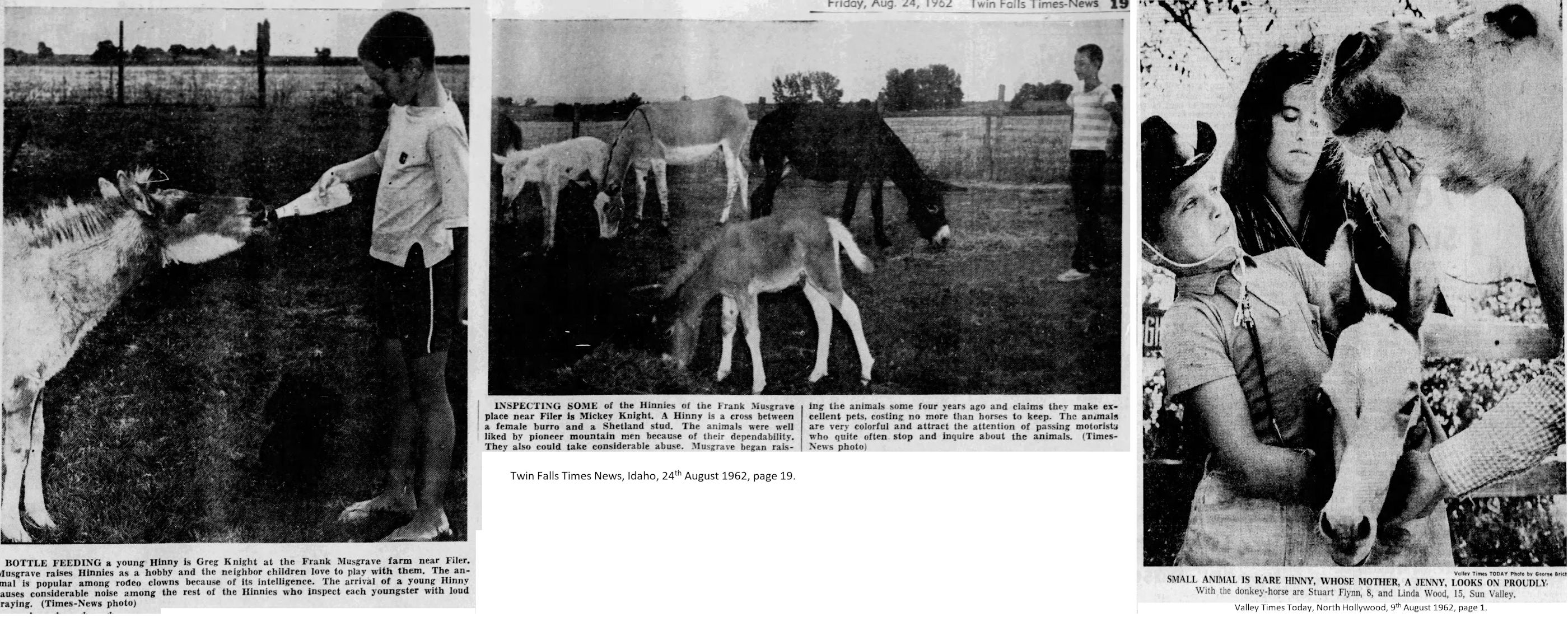
FAVORITE ANIMAL OF MOUNTAIN MEN IS RAISED BY FILER RESIDENT AS HOBBY. Twin Falls Times News, Idaho, 24th August 1962, page 19.
Filer, Aug. 24What is a "Jenny Hinny"? It's an animal. More specifically, it's the female product when a female burro and Shetland stud are crossed. According to Frank Musgraves, who raises these creatures, they are quite an animal. He originally planned to sell the animals, but so far he hasn't had the heart to part with too many of them.
Hinnies are more than just an odd animal. Most of the rodeo clowns ride a hinny during their performances. Musgraves claims Hinnies are intelligent creatures and readily can learn a number of tricks and stunts. A Hinny is the opposite product of mules. Mules are derived when a male burro is crossed with a female horse. The Hinny doesn't inherit the disposition of the rest of the jackass family. Hinnies are wonderful animals and good-natured, says Musgraves. They are more than just a show animal and a good pet. Many years ago the mountain men rode Hinnies. They were sure-footed and could take more abuse than other animals. This, plus their intelligence, made them a favorite for pack trips among early day trappers and hunters.
Producing Hinnies is a year-long job. The gestation period is 12 months. Musgraves noted that one animal carried her colt for 13 months and the creature had teeth when it was born. It was quite sickly and had to be bottle fed. The young colt [foal] stood in the mud for a few days and would crawl out to eat dirt. In a sense it nursed itself back to good health.
The birth of a young Hinny creates quite a bit of excitement among the other animals. According to Musgraves, all the other Hinnies gather round and inspect the new arrival. After each has looked the young Hinny over, they begin braying and creating quite a commotion. Then they parade around the new arrival.
The sight of these unusual creatures has caused many motorists to stop and inquire about them, and children love them says Musgraves. Raising Hinnies is no more expensive than raising horses. Musgraves, who is a carpenter, raises them as a hobby. He had one about 35 years ago and always wanted to start a Hinny farm. On his small acreage north of Filer, some four years ago, he got his start. Musgraves will sell his pets but it takes a good talker to buy one.
RARE HINNY BORN ON ZABOKRTSKY FARM; IS NOW FAMILY PET. The Fairbury Journal, Nebraska, 13th August 1964, page 1.
A lovable pet at the Zabokrtsky farm, southeast of Endicott, is a rarity in the animal kingdom and a great curiosity. "Sunflower" is the name given the hinny born there two weeks ago. A hinny is the offspring of a stallion and a female donkey or burro. This is in contrast to a mule, the product of a male donkey and a mare horse. Ted Zabokrtsky, who with his father, Louis Zabokrtsky, owns the hinny, reports only once out of a 100 does a hinny occur. This baby hinny, a light tan, has the same baldface as her horse father, but is developing the dark hairline down the spine, typical of the donkey or burro.
Hazel, the burro mother of Sunflower, was acquired about a year ago in February by the Zabokrtskys. Her first colt, born a year ago in April, is Jeannie, a full-blooded burro. Jeannie is being broken to drive with Hazel, the two pulling a small wagon.
Hinnies have a disposition more like that of a horse, according to a report of a veteran hinny breeder in Colorado, who has furnished the animals to pull wagons at such places as Disneyland. They are more dependable than a mule, dressier and gentler. Physically, a hinny has a horse-like head, neatly proportioned ears, also small round feet rather than the mule's long U-shaped hoofs. They possess the easy, shuffling gait of the mule and its surefootedness, and are easily trained.
"Sunflower is noisy, friendly, and has a lively sense of curiosity," Ted sald. "She will even try eating cigarets." Her stubbornness was revealed as Cindy and Jerry Zabokrtsky tried to lead the baby hinny around to pose for a picture. At present, Ted has no future plans for the hinny, for she will not be weaned until five or six months old. She may make an appearance at the historical pageant "Echoes of the Oregon Trail," Sunday, if the other burros take part.
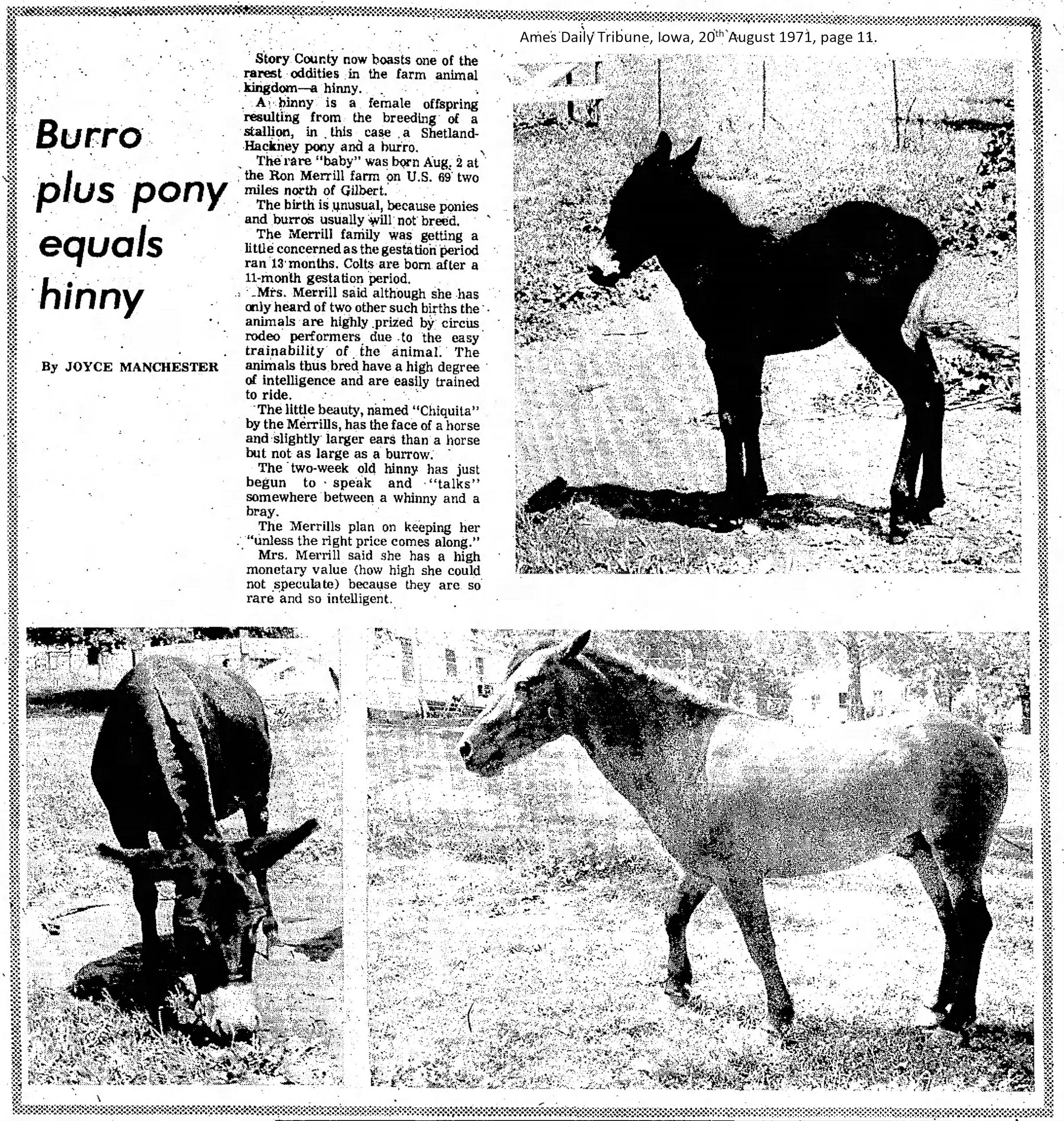
BURRO PLUS PONY EQUALS HINNY. Ames Daily Tribune, Iowa, 20th August 1971, page 11.
Story County now boasts one of the rarest oddities in the farm animal kingdom a hinny. A hinny is female offspring resulting from the breeding od a stallion, in this case a Shetland Hackney pony and a burro. The rare "baby" was born Aug. 2 at the Ron Merrill farm on U.S. 69 two miles north of Gilbert. The birth is unusual because ponies and burros usually will not breed. The Merrill family was getting a little concerned as the gestation period ran 13 months. Colts [foals] are born after a 11-month gestation period. Mrs. Merrill said although she has only heard of two other such births the animals are highly prized by circus rodeo performers due to the easy trainability of the animal. The animals thus bred have a high degree of intelligence and are easily trained to ride.
The little beauty, named "Chiquita" by the Merrills, has the face of a horse and slightly larger ears than a horse but not as large as a burro. The two-week old hinny has just begun to speak and "talks" somewhere between a whinny and a bray. The Merrills plan on keeping her "unless the right price comes along." Mrs. Merrill said she has a high monetary value (how high she could not speculate) because they are so rare and so intelligent.
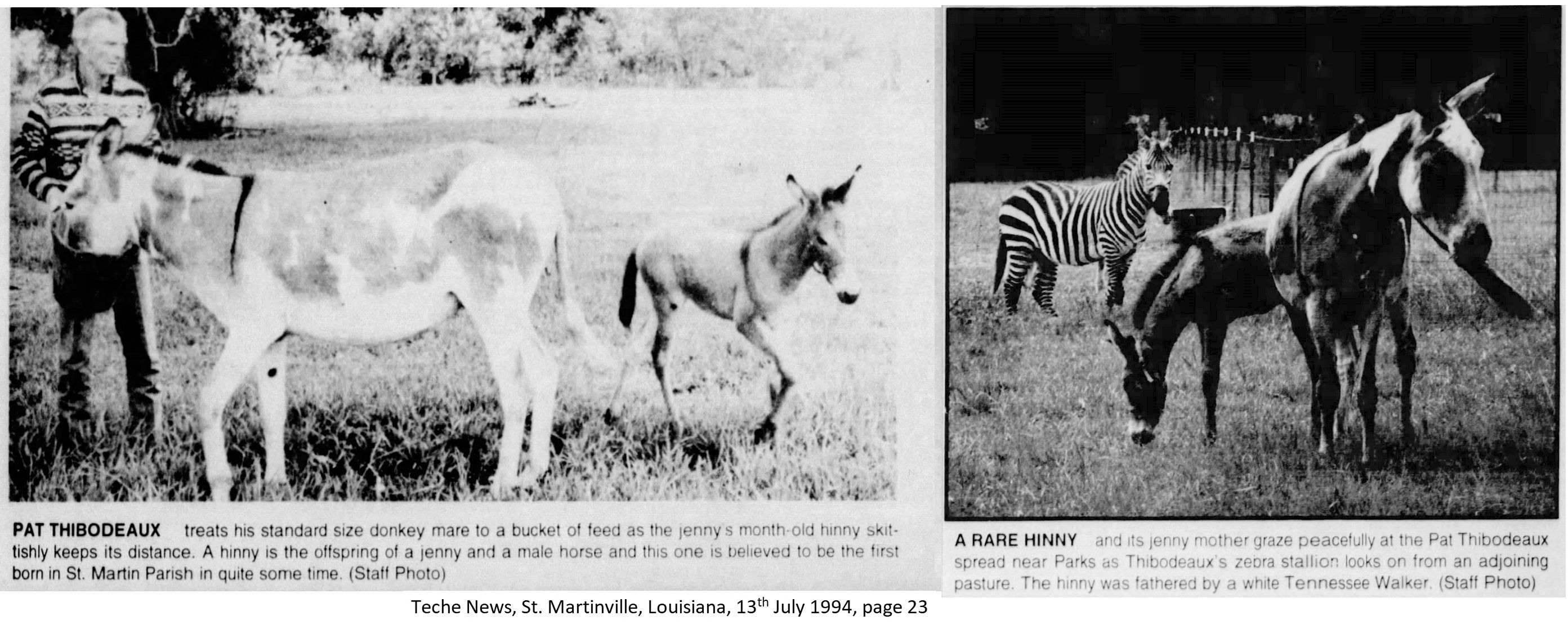
RARE HINNY BORN IN PARISH. Teche News, St. Martinville, Louisiana, 13th July 1994, page 23.
Odds are that few of you have ever heard of a hinny, much less had the opportunity to see one. The offspring of a male horse and female donkey, hinnys are relatively rare, and Breaux Bridge veterinarian Dr. Louis Huval says the hinny recently born to a jenny owned by Pat Thibodeaux of the Parks area is the first he knows of in St. Martin Parish in a long time. Years ago, before tractors contributed to the mechanization of farms, most farmers used mules for much of their field work. Mules, of course are the (almost always) sterile offspring of a jackass and a female horse and were common to the area through the Forties and even into the early Fifties.
[. . .]Most mules and donkeys are now used as saddle mounts rather than draft animals they're usually very sure footed and won't spook as quickly as most horses . . . According to Thibodeaux, not many people attempt to breed a donkey mare with a stallion. "I know of only one hinny breeder in Texas and another in Tennessee," he says. Thibodeaux decided he'd like to try for a "walking" hinny and found a man in Church Point with a beautiful white Tennessee Walker stallion to breed with his donkeys. Two of his jennys lost their foals, but one of his standards gave birth to a hinny during the first week of June. "I was hoping for a white hinny," Thibodeaux relates, "But it ended up bay coloured. It does look like he'll be a natural gaited walker, though, so it should be good for riding."
SHELBY HINNY MINUS WHINNY. The Decatur Daily Review, Illinois, 8th November 1959, page 5. Pana, Nov. 7. - The birth of an animal about a month ago on a Shelby County farm was awaited with unusual interest - because the animal itself is unusual. It is a hinny. Even years ago, when animals were used for labor, a hinny was a rarity. Today it is very rare. Webster defines a hinny as "a hybrid between a stallion and an ass". In the case of the Shelby County hinny, the stallion was a pony, and the ass a burro. Veterinarians say that cross-breeding of this type is seldom successful. One said that in eight years of practise, the is the third hinny he has heard of.
Keith Stokes, an insurance agent of Shelbyville, in partnership with Lynn McElroy of Westervelt in 1957 bought 50 burros in Mexico. They brought the animals to Shelbyville and sold them, mostly in central Illinois, and some in Michigan and Indiana. They each kept one and Stokes took his burro mare to Harold Pinkston, who has a pony stallion service. Successful in one attempt, Stokes is hopeful of a second success, so that he may have a matched pair of hinnies. Stokes has the animals for pets. [. . .]
The little colt is a grey-brown color, while its burro mother is silver grey. The pony father is a sorrell [chestnut] with white mane and tail. The hinny resembles its burro mother, but it has a different nose, and its tail and mane are like a pony's. Mrs. Virginia Pinkston, who has had most of the care of the animals, said that it has the "hee-haw" of a burro instead of the whinny of a pony which she had hoped for.
FERTILE MULES AND HINNIES
FERTILITY OF HYBRIDS. (The Field, 25th September 1897) I have noticed some correspondence in your columns concerning the fertility of hybrids and think that the following may be of interest, and at all events it will give an opportunity to some of your readers of thorough investigation. Some years ago I was driving up from Perarolo to Cortina d'Ampezzo, and noticed several very peculiar looking animals, which to my eye were neither mules nor hinnys. My driver, a very intelligent man, one of the Apollonio family of Cortina, at once gave me their history, pointing out that this one was by a male mule out of a female hinny, and that one by a male hinny out of a female mule. He was perfectly familiar with the appearance of each breed, and declared that all these crosses were fertile. Ile told me what, indeed, I could see for myself, that these crosses, or descendants of crosses, were quite common in that part ; but added that he did not think that they had any good points about them. As to mules, he disliked them on account of their character, but admired their capacity for work. If he had to go over the e ground every day, then he would have a mule or mules; but as they dislike being put out of their groove, and resent it, horses suited him better. The mule, he said, is sly, and one must be always on one's guard with him. - M. D.
[There can be no doubt that there is some error in the account. In the Poitou district, where very large numbers of mules are bred annually, a fertile mule is unknown ; and M. Ayrault, in his valuable work, "De l'lndustrie Mulassiere," gives statements that are quoted in their work on "Horses, Mules, &c." by Messrs Tegetmeier and Sutherland, showing that the mules there are in the most favourable conditions for breeding , but are never fertile. The sterility of equine mules is fully discussed in this work.ED.]
Mules and hinnies are usually infertile (asses have 62 chromosomes, horses have 64, hybrids have 63; as well as different numbers, the chromosomes have different structures), but since 1527 there have been more than 60 foals born to female mules around the world and probably additional unreported ones. However, mollies have a strong maternal drive and will kidnap foals of horses and donkeys sharing the same paddock.
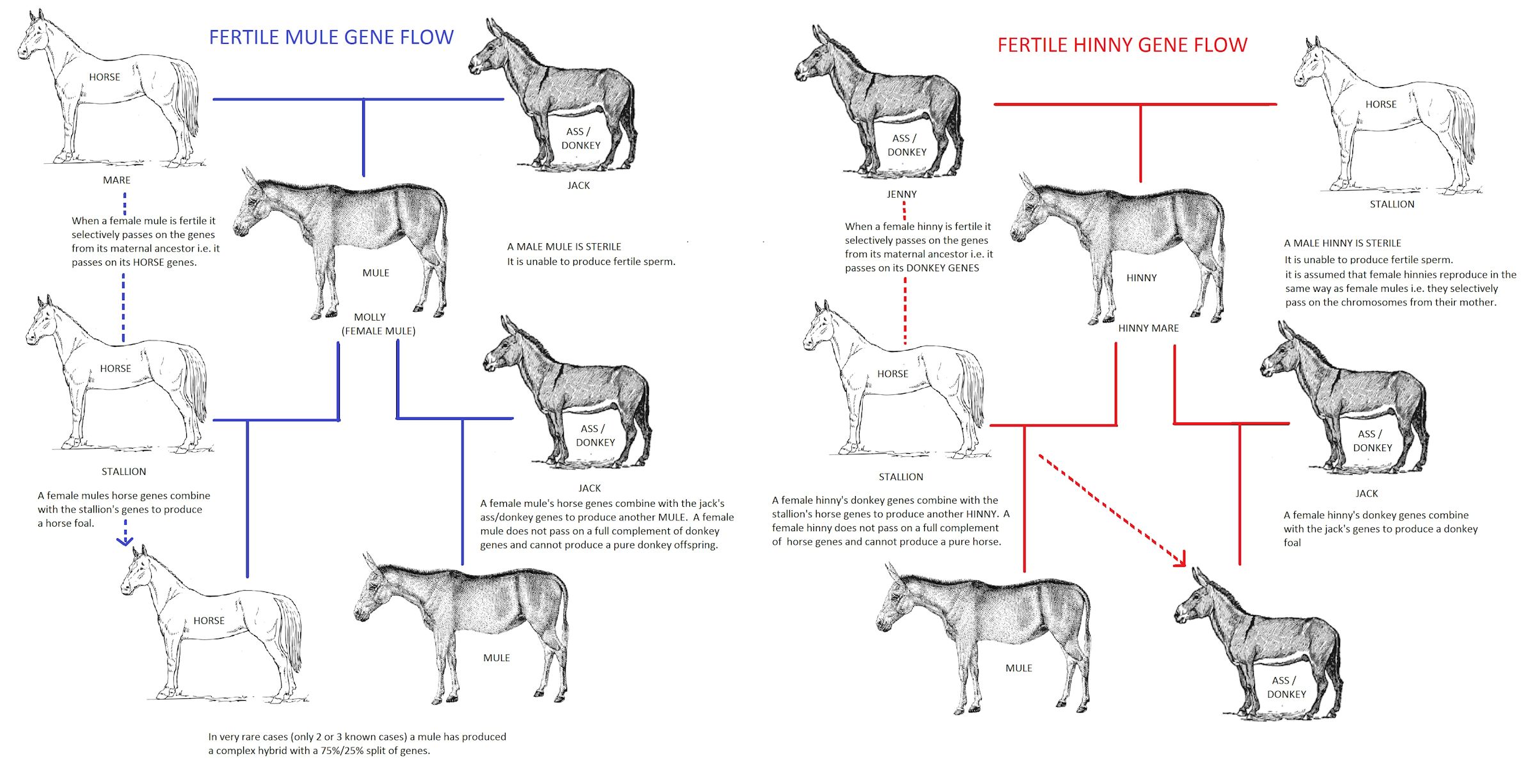
Mules are generally sterile, but several female mules have produced offspring when mated to a purebred horse or ass. This is so rare that the Romans had a saying, "cum mula peperit," meaning "when a mule foals" - the equivalent of "when hell freezes over." When a mule gave birth in Albania in 1994, it was thought to have unleashed the spawn of the devil on a small village. When a mule gave birth in 2002 in Morocco five years ago, locals feared it signalled the end of the world.
From The Royal Natural History, edited by Richard Lydekker and published 1894: There appear to be no authenticated instances of mules breeding among themselves; although the female mule will occasionally produce offspring with the male horse or ass. And it is somewhat remarkable that it does not appear that the hybrids between any other members of the Equine family are mutually fertile.
However, Cornevin and Lesbre stated that in 1873 an Arab mule was fertilized in Africa by a horse stallion, and produced female offspring. Both parents and the offspring were taken to the Jardin d'Acclimatation in Paris where the mule had a second female colt sired by the same stallion and then two male colts, one sired by an ass and the other by a horse stallion. The female progeny were fertile, but their offspring were feeble and died at birth. Cossar Ewart gives an account of a recent Indian case in which a female mule gave birth to a male colt. The best documented fertile mule mare was "Krause" who had 2 male offspring, both sired by her own sire. It is now known that in most fertile mule mares, the mare passes on a complete set of her maternal genes (i.e. from her horse/pony mother) to the foal rather than a mixture of chromosomes. A female mule bred to a horse will therefore produce a 100% horse foal.
In 1898, an Indian pack-mule produce a pony-like foal. In the 1920s, a mule mare called "Old Beck" (Texas A&M) produced a mule daughter called "Kit". When Old Beck was bred to a horse stallion she produced a horse son (he sired horse foals). When bred to a donkey, she produced mule offspring. Likewise, a mare mule in Brazil has produced two 100% horse sons sired by a horse stallion. There is an unverified case of a mare mule that produced a mule daughter (this may be another account Old Beck). The daughter was also fertile and produced a horse-like foal with some mule traits; this was dubbed a "hule". There are no reports as to whether the hule was fertile; it may have been castrated in the same way as a mule stallion. After "Old Beck's" case came to light, several others were reported but no definite proof was available concerning most of those.
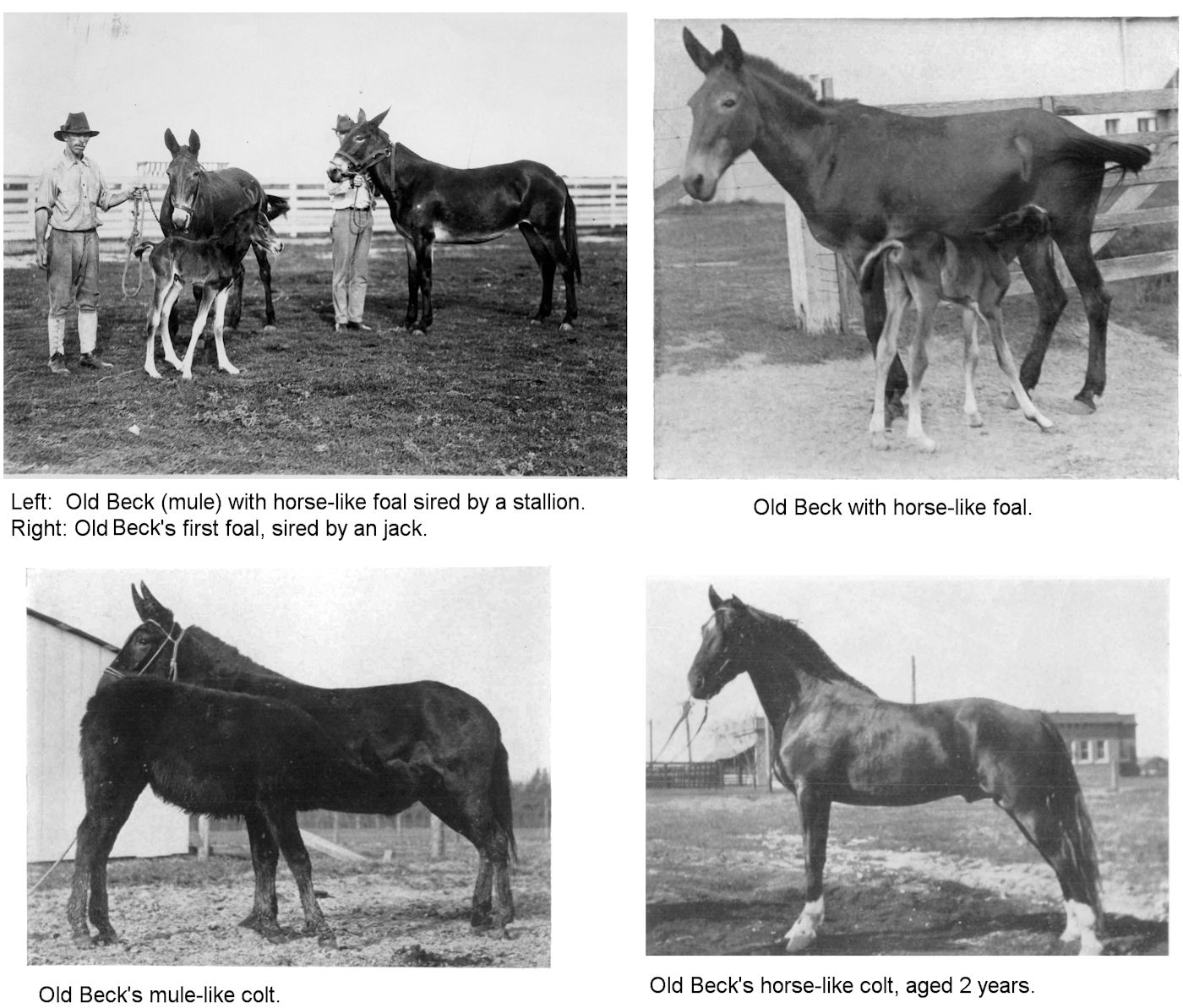
A molly gave birth to 2 foals in Nebraska in the mid-1980s. The event prompted the first genetic testing of a mule's offspring. Tests showed no evidence the mother passed along any genetic markers from her donkey father, who was also the father of the foals. This is called "hemiclonal transmission". She passes on only her horse DNA with no shuffling of horse and donkey genetic material.
In April 2007, a 7 year old black molly, "Kate", owned by ranchers Larry and Laura Amos gave birth at a Grand Mesa ranch near to Colbran. Kate was one of 10 mules purchased from Pleasant Plains, Arkansas and would already have been pregnant. Genetic testing at the University of Kentucky and the University of California at Davis confirm that Kate is a mule and that the foal is her offspring. This rules out stolen foals that were donkeys or mulish-looking horses. Her son has a donkey-like appearance suggesting the father was a donkey and, because female mules usually only pass on their maternal horse DNA, that he is a mule.
A fertile hinny in China is believed to be a unique case. Her offspring was sired by a donkey. Named "Dragon Foal", one would have expected a donkey foal if the mother had passed on her maternal chromosomes in the same way as a mule. However, Dragon Foal appears to be a strange donkey with some mule-like features. Her chromosomes and DNA tests confirm she is a previously undocumented combination. In Morocco, a mare mule produced a male foal that is 75% donkey and 25% horse i.e. she passed on a mixture of genes instead of passing on her maternal chromosomes. There are no recorded cases of fertile mule stallions.
Asses have 62 chromosomes, horses have 64 so the hybrids have 63 chromosomes that are a mixture of one from each parent. As well as different numbers, the chromosomes have different structures. The different structure and number usually prevents the chromosomes from pairing up properly and creating successful embryos. When there's an odd number of chromosomes, meiosis (cell division to form gametes (egg or sperm cells)) doesn't work correctly. This causes hybrid sterility. Nature has a way round this called meiotic drive. Genes from each parent become tightly linked instead of independently assorted. The genes from one parent - usually the mother - will be over-represented in the gametes produced by the hybrid offspring. Normally when cells divide to form gametes, a random mix of maternal/paternal alleles ends up in each gamete. With meiotic drive, there is distinct segregation of maternal and paternal alleles: all the horse genes end up on one side of the cell and all the donkey genes end up on the other. The cell then splits unevenly. Only one of those daughter cells will get the necessary machinery for life (genes from the mother, mitochondria, cytoplasm etc) while the other cell is discarded along with all the genes from the father! In fertile mule mares, the mare passes on a complete set of her maternal genes (i.e. from her horse/pony mother) to the foal. A female mule bred to a horse will therefore produce a 100% horse foal (which is fertile) while a female mule bred to an ass will produce another mule. It seems to be nature's way of letting a female mate with a related species, but preserving the genes from the female side of the family so the hybrid descendent can produce a purebred offspring.
Chandley, A & Jones, Russell & Dott, H & Allen, W & Short, Roger. (1974). MEIOSIS IN INTERSPECIFIC EQUINE HYBRIDS. I. THE MALE MULE (EQUUS ASINUS X E. CABALLUS) AND HINNY (E. CABALLUS X E. ASINUS). Cytogenetics and cell genetics. 13. 330-41.
This mentions that a few spermatozoa are occasionally seen in the male mule, hinny and zebra-horse hybrid and that "a few oocytes can be found in the ovaries of female mules and hinnies and may even be successfully ovulated." There was a possibility either of sperm having twice the normal chromosome complement (diploid instead of haploid) or that a few germ cells survived cell division and that the donkey chromosomes segregated into one daughter cell while the horse chromosomes segregated into the other daughter cell.
DARWIN ON HYBRID EQUIDS
In "Origin of Species" (1859) Charles Darwin mentioned four coloured drawings of hybrids between the ass and zebra. He noted "In Lord Moreton's famous hybrid from a chestnut mare and male quagga, the hybrid, and even the pure offspring subsequently produced from the mare by a black Arabian sire, were much more plainly barred across the legs than is even the pure quagga. Lastly, and this is another most remarkable case, a hybrid has been figured by Dr. Gray (and he informs me that he knows of a second case) from the ass and the hemionus." Darwin described the latter hybrid in "The Variation Of Animals And Plants Under Domestication": The Equus indicus [onager] a hybrid, raised at Knowsley ('Gleanings from the Knowsley Menageries' by Dr. J.E. Gray.) from a female of this species by a male domestic ass, had all four legs transversely and conspicuously striped, had three short stripes on each shoulder and had even some zebra-like stripes on its face! Dr. Gray informs me that he has seen a second hybrid of the same parentage, similarly striped.
In his "The Variation Of Animals And Plants Under Domestication", Darwin wrote: "I have seen, in the British Museum, a hybrid from the ass and zebra dappled on its hinder quarters. [...] Many years ago I saw in the Zoological Gardens a curious triple hybrid, from a bay mare, by a hybrid from a male ass and female zebra. and further described Moreton's hybrid; In the famous hybrid bred by Lord Morton ('Philosoph. Transact.' 1821 page 20.) from a chestnut, nearly purely-bred, Arabian mare, by a male quagga, the stripes were "more strongly defined and darker than those on the legs of "the quagga." The mare was subsequently put to a black Arabian horse, and bore two colts, both [...] plainly striped on the legs, and one of them likewise had stripes on the neck and body.
In that book, Darwin concluded: "The ass has a prepotent power over the horse, so that both the mule and the hinny more resemble the ass than the horse; but that the prepotency runs more strongly in the male-ass than in the female, so that the mule, which is the offspring of the male-ass and mare, is more like an ass, than is the hinny, which is the offspring of the female-ass and stallion." In "The Variation Of Animals And Plants Under Domestication" Darwin elaborated: "Colin, who has given in his 'Traite Phys. Comp.' tome 2 pages 537-539, [...] is strongly of opinion that the ass preponderates in both crosses, but in an unequal degree. This is likewise the conclusion of Flourens, and of Bechstein in his 'Naturgeschichte Deutschlands' b. 1 s. 294. The tail of the hinny is much more like that of the horse than is the tail of the mule, and this is generally accounted for by the males of both species transmitting with greater power this part of their structure; but a compound hybrid which I saw in the Zoological Gardens, from a mare by a hybrid ass-zebra, closely resembled its mother in its tail.)"
In "Darwinism An Exposition Of The Theory Of Natural Selection With Some Of Its Applications" (1889), Alfred Russel Wallace commented: "Crosses between the two species of zebra, or even between the zebra and the quagga, or the quagga and the ass, might have led to a very different result."
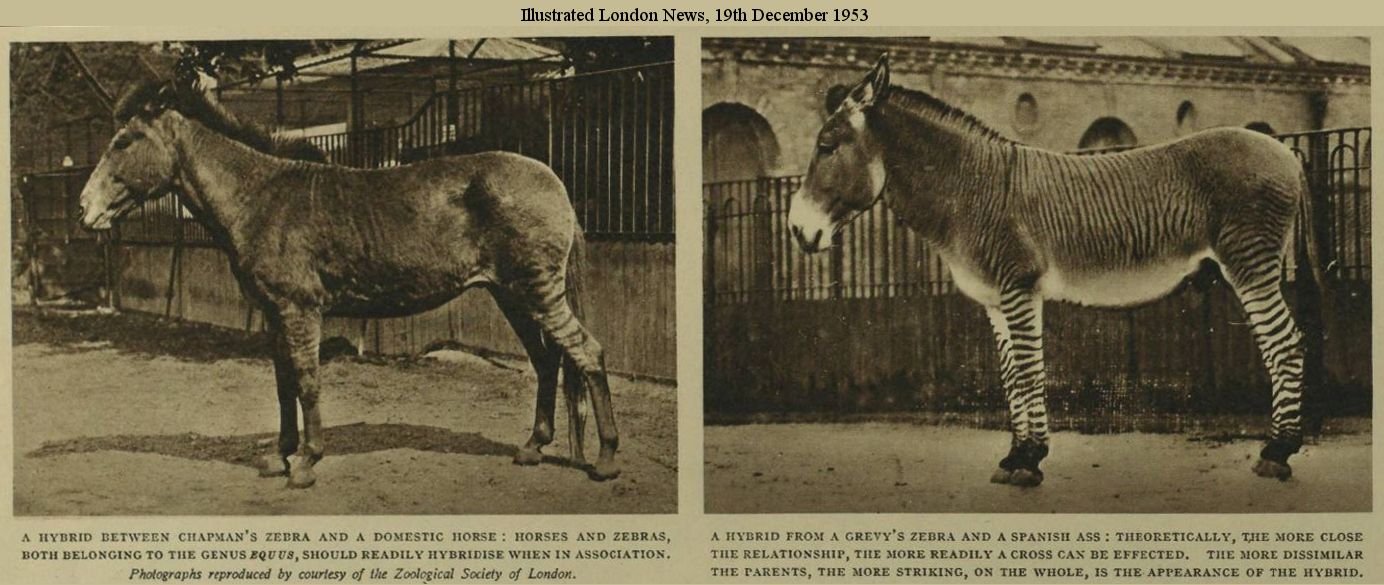
Textual content is licensed under the GFDL.
|
BACK TO HYBRIDS & MUTANTS INDEX INDEX |